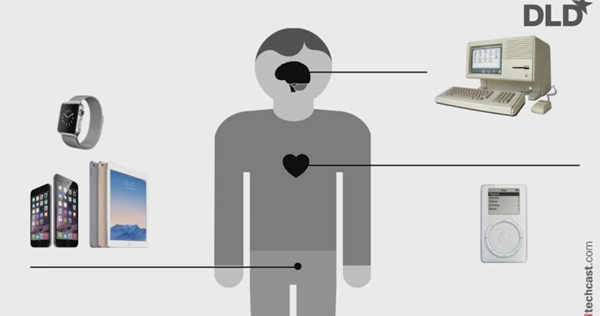Wearables, drones and beacons: Where is technology taking marketing?
Lena Roland
Warc
How will new innovative technology such as wearable devices, iBeacons and drones affect brands? And how will consumers interact with brands in the emerging Internet of Things, hyper-connected era? These were some of the questions addressed at Moving Minds, an event held by Kinetic, the media agency, in their central London office in March 2015.
Despite all the publicity, the wearables sector has not yet resonated with the mass market and has been hindered by "backward thinking", according to Tamara Sword, director of technology marketing specialist TMR&C . She pointed to Google Glass, the internet connected eyewear, which earlier this year stopped selling to the consumer market: "a lot of hype and zero adoption", she said, and that was because there was no real consumer need for the product. "It should be put back in the drawer where it belongs."
Google Glass and other wearable devices are failing because they do not fit the three main drivers of consumer adoption, Sword argued. Citing the work of Scott Galloway, clinical professor of marketing at NYU Stern School of Business, she declared these to be:
-
Survival: this is about meeting basic needs and Sword explained how cheaper own-label brands cater to this need.
-
Love: this is where consumers are prepared to pay a premium price for goods as it's an expression of love for others. It might explain why mums buy Pampers nappies over cheaper own-label brands.
-
Reproduction: this involves self-expression and attraction. A man wearing a Rolex watch, for example, will signal to a woman that he will be able to take better care of her children than a man wearing a cheaper watch, thus "all luxury is in the game of reproduction and self-expression", Sword stated.
One brand that has recognised and catered to these three principles is Apple, the iconic technology brand. The "Think Different" campaign, Sword explained, appealed to our brains and therefore fitted the first principle (survival). Later, the Apple iPod focussed on music and passion thus fitting the second (love), and more recently, the iPhone, through its luxury positioning, appeals to the third principle and the idea of reproduction.

Apple's success is down to clear positioning – "it's not just about the technology", Sword said. It has successfully positioned itself as a luxury brand and, according to Galloway, is "the ultimate self-expression brand".
From iWatch to iWhatnext..?
While the wearables market has been slow to take off with the mass market, Sword was nonetheless optimistic about the prospects for the industry, declaring that "technology is staging an intervention in the shape of smartwatches". Specifically, Sword was referring to the launch of the Apple Watch.
Apple, Sword explained, "uses the language of seduction" which makes consumers "willing to pay a premium price for their product". To reinforce this point Sword showed the launch video for the Apple Watch featuring Sir Jonathan Ive, senior vice president of design at Apple, which featured words such as personal, intimacy, compulsion, embrace, conceived, inspire and desire to describe the new product.
Sword said the traditional watch industry was "in denial at the moment" and reeled off some sales figures that should be cause for concern. Apple, she explained has a customer base of 315 million consumers worldwide and the company intends to ship 30 million smartwatches in year one. The watch industry, and indeed all industries, need to "recognise how disruptive that is", Sword warned. "Who else is in denial?" she asked. Apple "will be the biggest watch company out of the gate" and "what's to stop Apple there?" Sword suggested the brand could launch a wearable device in clothes, jewellery, handbags – we need to think about "where could Apple go next, and how will it disrupt?" she insisted.
So what does all this mean for innovation and for brands? There is an obvious concern that wearables may become just another "new channel to shout at people from", but Sword insisted that marketing on smartwatches should be limited to nudge marketing, defined as "small, less intrusive micro-interactions". Explicit and invasive strategies will not work on wearables.
Drones – gimmick or not?
With so much hype about wearables, Sword said it was vital to separate the significant from the gimmicky. Drones, she suggested, are going to be "one of the most transformative technologies in our lifetimes". Major tech behemoths such as Amazon, Facebook and Google are all investing in drones, the unmanned aircraft technology which has traditionally been the preserve of the military. These tech giants "are very plugged into the eco-system", said Sword, and are "very smart at acquisition" – they effectively own the drones market.
In the US, the Association of National Advertisers has highlighted several areas where brands might consider using drones for commercial purposes. Delivery is the aspect that has generated most coverage – Amazon leading the way with its film showing how customer orders could be fulfilled within one hour. The film itself illustrates another use for drones – in helping to create content for brands. There are also possibilities around "dronevertising", a form of location-based advertising, and brand building, but there are formidable regulatory issues to be overcome before any of these become a reality.
To iBeacon or not to iBeacon?
The potential of iBeacons, the technology that allows every device powered by Apple's iOS 7 to transmit and receive unique signals via Bluetooth, across a distance up to 150 feet, have generated much discussion in the industry.
Roshan Singh, head of digital innovation at Kinetic, wondered whether or not advertisers should push this new technology which allows brands and retailers to target individual shoppers within stores with ads or coupons. But Miles Quitmann, chief commercial officer at Proxama, a mobile proximity commerce platform, was clear: brands that get their iBeacon strategy wrong will be a "nightmare" for marketers as they have such potential to be regarded as spam. If consumers have not opted in, or given their consent to be targeted in such a personal way, "they will just turn off Bluetooth or delete the app", he argued. Thus brands must "allow the control of the engagement to be with the user", and marketers should only push "if you've been told that it's ok (to push)".
Prask Sutton, co-founder and chief innovation officer, Nock, an interaction and UX design agency, maintained the key was to give consumers a compelling reason to opt in rather than opt out. This can be achieved through interesting, fun, engaging and relevant ads, he said. Further, brands must create content that people want to consume – in the moment, when they want it is how it's best served, he said. Quitmann concurred: brands have to be relevant by providing "glimpse-able or glance-able moments" or "short blasts of a look at something", which act as "nudge moments", he explained.
Future trends
Roshan Singh outlined Kinetic's key technology trends and gave an indication of how far away these are from really taking off:
-
Internet of Things (IoT): Singh described this as "a shared standardised framework that all data travels on" which will allow brands to utilise data in new and interesting ways. By 2030, machine-to-machine (M2M) will make up over 50% of all data passing through the internet, he said. The IoT is four years away, he predicted.
-
Deep learning: this involves using algorithms in new ways "to build real correlations", Singh said. The technology is seven years away.
-
Virtual reality (VR): this "was science fiction, now its fact", he declared. VR devices such as Oculus Rift allow for immersive and engaging experiences and are predicted to be three years from mass take-up.
-
Vanished interfaces: this involves computer human interfaces and eye and brainwave tracking. Three years away.
-
Near Field Communications (NFC): Singh insisted NFC technology is "not dead" but has been in a "trough of disillusionment" and is still not being used properly. That said, he predicts it is two years from adoption.
-
Driverless cars: Google's self-driving car has "a million miles without incident", something "no human has done", Singh noted. There are obvious implications for outdoor advertising here – "if we're not focusing on cars, what are we looking at?" Singh pondered. The reality of the tech is 15 years away, he said.
A subsequent panel discussed issues around data and security that have yet to be fully resolved in a hyper-connected digital age. Proxama's Quitmann suggested that future consumers might be able to take a smart pill that would monitor their health, but asked what happened if their healthcare data was hacked. That "could become a life or death issue", he said, although he was optimistic these issues would be addressed over the next decade.
Kinetic's Singh asked who owned all the data now being generated – brands, consumers or stakeholders? There were no definitive answers but Quitmann argued that, in the media environment, "individual data for a campaign is owned by the brand". Nock's Sutton felt that in the end it would come down to security: "whichever brand has the best security is where the power will sit", he said.
 Lena Roland is Warc's Knowledge Officer.
Lena Roland is Warc's Knowledge Officer.

